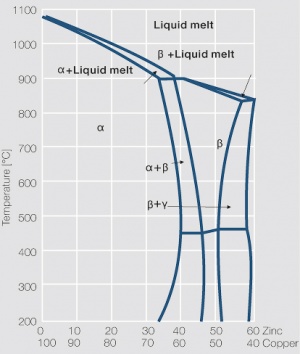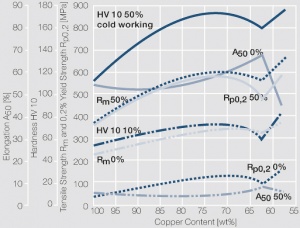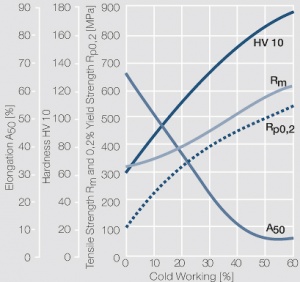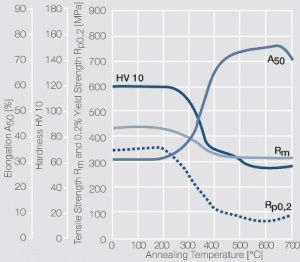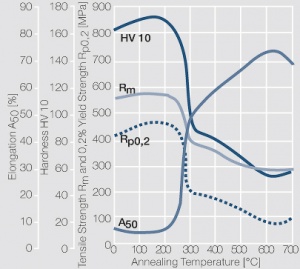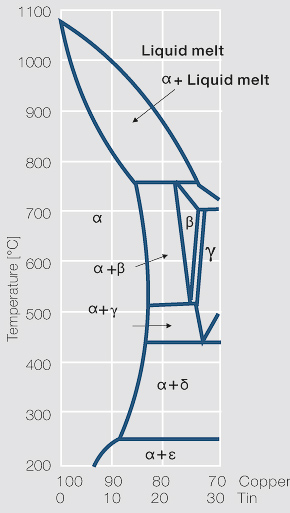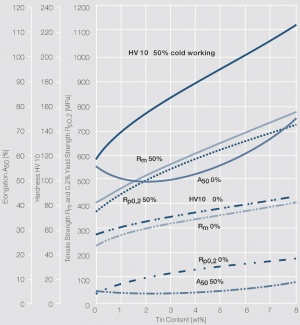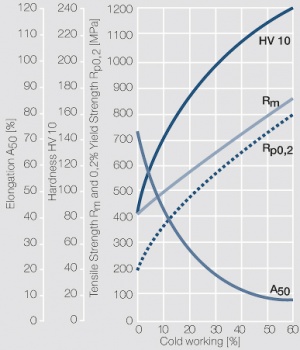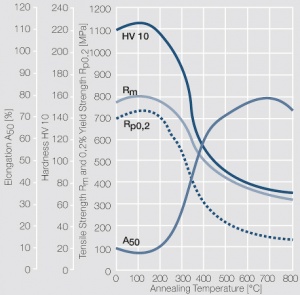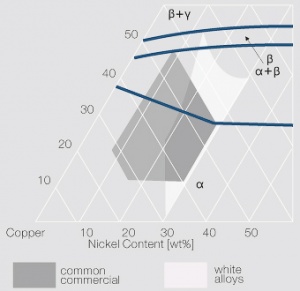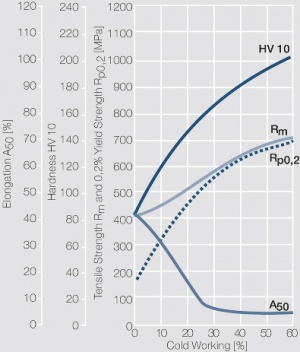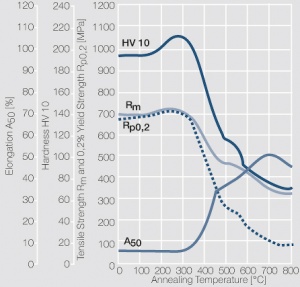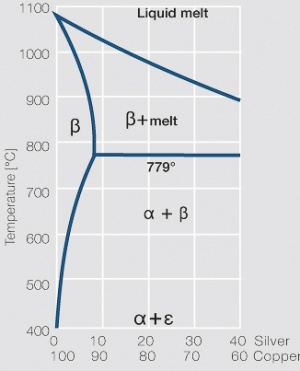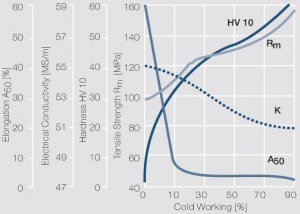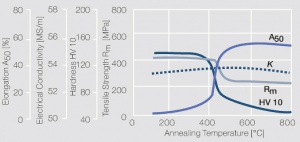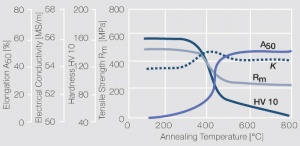Difference between revisions of "Naturally Hard Copper Alloys"
(→5.1.4.2 Copper-Tin Alloys (Tin Bronze)) |
(→5.1.4.3 Copper-Nickel-Zinc Alloys (German Silver)) |
||
| Line 92: | Line 92: | ||
====5.1.4.3 Copper-Nickel-Zinc Alloys (German Silver)==== | ====5.1.4.3 Copper-Nickel-Zinc Alloys (German Silver)==== | ||
| − | Despite its lower electrical conductivity, the good spring properties, high corrosion resistance, and the good workability make copper-nickel-zinc alloys a frequently used spring contact carrier in switches and relays. As illustrated in the phase diagram the most commonly used materials are in the " -range which means that they are single-phase alloys | + | Despite its lower electrical conductivity, the good spring properties, high corrosion resistance, and the good workability make copper-nickel-zinc alloys a frequently used spring contact carrier in switches and relays. As illustrated in the phase diagram the most commonly used materials are in the " -range which means that they are single-phase alloys <xr id="fig:Copper rich region of the ternary copper-nickel-zinc phase diagram with indication of the more commonly available german silver materials"/> (Fig. 5.14). The formability and strength properties of german silver are comparable to those of the copper-tin alloys. The work hardening and softening behavior is illustrated on the example of CuNi12Zn24 in Figures 5.15 and 5.16. |
The relaxation behavior of Cu-Ni-Zn alloys is superior to the one for the tin bronzes. Additional advantages are the very good weldability, brazing | The relaxation behavior of Cu-Ni-Zn alloys is superior to the one for the tin bronzes. Additional advantages are the very good weldability, brazing | ||
properties, and the high corrosion resistance of these copper-nickel-zinc alloys. | properties, and the high corrosion resistance of these copper-nickel-zinc alloys. | ||
| + | <figure id="fig:Copper rich region of the ternary copper-nickel-zinc phase diagram with indication of the more commonly available german silver materials"> | ||
Fig. 5.14: Copper rich region of the ternary copper-nickel-zinc phase diagram with indication of the more commonly available german silver materials | Fig. 5.14: Copper rich region of the ternary copper-nickel-zinc phase diagram with indication of the more commonly available german silver materials | ||
[[File:Copper rich region of the termary copper nickel zinc phase diagram.jpg|right|thumb|Copper rich region of the ternary copper-nickel-zinc phase diagram with indication of the more commonly available german silver materials]] | [[File:Copper rich region of the termary copper nickel zinc phase diagram.jpg|right|thumb|Copper rich region of the ternary copper-nickel-zinc phase diagram with indication of the more commonly available german silver materials]] | ||
| + | </figure> | ||
'''Table 5.11: Physical Properties of Copper-Nickel-Zinc Alloys''' | '''Table 5.11: Physical Properties of Copper-Nickel-Zinc Alloys''' | ||
Revision as of 16:51, 5 March 2014
Alloys like brasses (CuZn), tin bronzes (CuSN), and German silver (CuNiZn), for which the required hardness is achieved by cold working are defined as naturally hard alloys. Included in this group are also the silver bronzes (CuAg) with 2 – 6 wt% of Ag.
Contents
5.1.4.1 Copper-Zinc Alloys (Brasses)
Copper-zinc alloys are widely used as contact carrier materials in switching devices for electrical power engineering because of their high electrical conductivity, the higher mechanical strength combined with good formability compared to pure copper (Tables 5.7 and 5.8), and at the same time their reasonable economic costs. Especially suitable are the brasses with up to 37 wt% Zn content which are according to the phase diagram all made up from the " -phase of the CuZn system Figure 1(Fig. 5.5). It is important to note the strong dependence of the electrical conductivity and mechanical strength on the zinc content Figure 2(Fig. 5.6).
The main disadvantages of these alloys are with increasing zinc content the also increasing tendency towards tension crack corrosion and the poorer stress relaxation properties compared to other copper alloys.
One of the special brass alloys used as a contact carrier material is CuSn23Al3Co. This material exhibits significantly higher mechanical strength than the standard brass alloys. Even so this material is a naturally hardening alloy, a suitable heat treatment allows to further increase its strength.
Figure 1 Fig. 5.5: Strain hardening of Ag 99.95 by cold working
Figure 2 Fig. 5.6: Mechanical properties of brass depending on the copper content (after cold working of 0 and 50%)
Figure 3 Fig. 5.7: Strain hardening of CuZn36 by cold forming
Figure 4 Fig. 5.8: Softening of CuZn36 after 3 hrs annealing after 25% cold working
5.1.4.2 Copper-Tin Alloys (Tin Bronze)
Because of their good elastic spring properties and formability the copper-tin alloys CuSn6 and CuSn8 are standard materials for spring contact elements in electrome-chanical components such as connectors, switches, and relays (Tables 5.9 and 5.10). Besides these other alloys such as CuSn4 and CuSn5 and the multi-metal tin bronze CuSn3Zn9 have significant usage – mainly in North America. Figure 5.10 Figure 5 shows the copper rich side of the phase diagram for the CuSn system. The mechanical property values achieved by cold forming are superior to these of the brass alloys Figure 6(Fig. 5.11). They increase significantly with increasing Sn content. The work hardening and softening behavior are shown for the example of CuSn8 in Figure 7 Figures 5.12 and Figure 8 5.13. The stress relaxation properties for CuSn alloys are good for up to 100°C, deteriorate however quickly for temperatures above 150°C.
Fig. 5.9: Softening of CuZn36 after 3 hrs annealing after 50% cold working
Table 5.7: Physical Properties of Selected Copper-Zinc Alloys
2 teile!
Table 5.8: Mechanical Properties of Selected Copper-Zinc Alloys
2 teile!
Table 5.9: Physical Properties of Copper-Tin Alloys
2 teile!
Table 5.10: Mechanical Properties of Copper-Tin Alloys
2 teile!
Figure 6 Fig. 5.11: Mechanical properties of tin bronze depending on the tin content (cold working 0 and 50%)
Figure 7 Fig. 5.12: Strain hardening of CuSn8 by cold working
Figure 8 Fig. 5.13: Softening of CuSn8 after 3 hrs annealing after 50% cold working
5.1.4.3 Copper-Nickel-Zinc Alloys (German Silver)
Despite its lower electrical conductivity, the good spring properties, high corrosion resistance, and the good workability make copper-nickel-zinc alloys a frequently used spring contact carrier in switches and relays. As illustrated in the phase diagram the most commonly used materials are in the " -range which means that they are single-phase alloys Figure 9 (Fig. 5.14). The formability and strength properties of german silver are comparable to those of the copper-tin alloys. The work hardening and softening behavior is illustrated on the example of CuNi12Zn24 in Figures 5.15 and 5.16.
The relaxation behavior of Cu-Ni-Zn alloys is superior to the one for the tin bronzes. Additional advantages are the very good weldability, brazing properties, and the high corrosion resistance of these copper-nickel-zinc alloys.
Table 5.11: Physical Properties of Copper-Nickel-Zinc Alloys
2 teile!
Table 5.12: Mechanical Properties of Copper-Nickel-Zinc Alloys
2 teile!
Fig. 5.15: Strain hardening of CuNi12Zn24 by cold working
Fig. 5.16: Softening of CuNi12Zn24 after 3 hrs annealing after 50% cold working
5.1.4.4 Copper-Silver-(Cadmium) Alloys (Silver Bronze)
Besides the low-allowed CuAg0.1 other copper materials with higher silver contents (2-6 wt%) are also used as contacts carrier materials. Some of them contain additionally 1.5 wt% Cd. The phase diagram (Fig. 5.17) shows that in principle the CuAg alloys can be precipitation hardened, but the possible increase in mechanical strength is rather small.
Copper-silver alloys have good spring properties and compared to other spring materials have a high electrical conductivity (Tables 5.13 and 5.14). The mechanical strength values in the strongly worked condition are comparable to those of the copper-tin alloys. Work hardening and softening behavior are shown for the example of CuAg2 (Figs. 5.18 – 5.20). For the relaxation behavior the silver bronzes are superior to German silver and tin bronze.
Because of their good spring properties combined with high electrical conductivity silver bronzes are suitable for the use contact springs in relays under higher current loads. Taking advantage of their high temperature stability they are also used as current carrying contacts in high voltage switchgear and as electrode material for resistance welding.
Fig. 5.17: Phase diagram of copper-silver for the range of 0 – 40 wt% silver
Table 5.13: Physical Properties of Selected Copper-Silver-(Cadmium) Alloys
2 teile!
Table 5.14: Mechanical Properties of Selected Copper-Silver-(Cadmium) Alloys
2 teile!
Fig. 5.18: Strain hardening of CuAg2 by cold working
Fig. 5.19: Softening of CuAg2 after 1 hr annealing after 40% cold working
Fig. 5.20: Softening of CuAg2 after 1 hr annealing after 80% cold working
